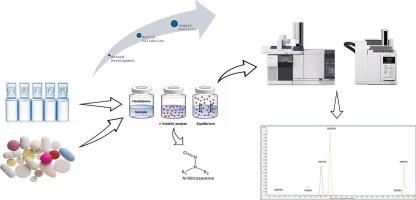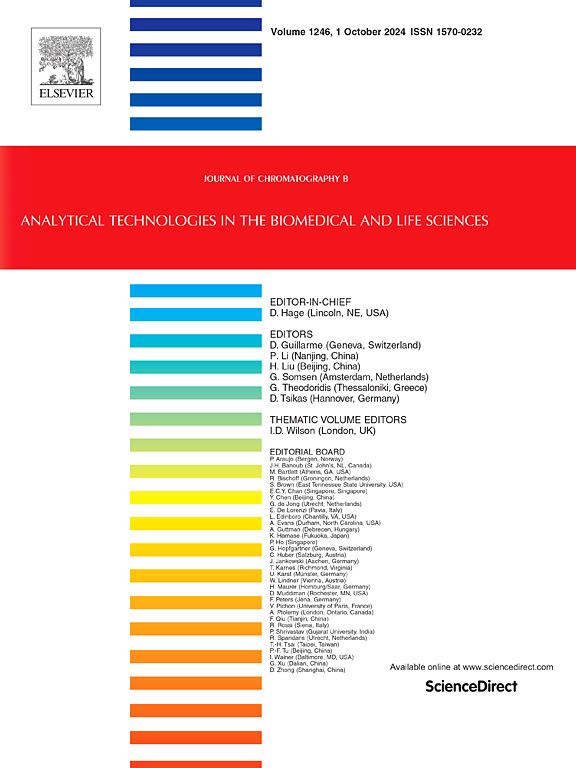顶空模块GC-MS/MS与自动进样器溶剂排气方式同时测定不同剂型中6种亚硝胺:开发与验证。
IF 2.8
3区 医学
Q2 BIOCHEMICAL RESEARCH METHODS
引用次数: 0
摘要
n -亚硝胺的测定在医药产品中具有重要意义。本研究设计并验证了一种准确、简便地测定亚硝胺的分析方法,从而消除了各种剂型中基质的干扰效应。分别测定悬浮液、乳剂和片剂中n -亚硝基二乙胺(NDEA)、n -亚硝基二甲胺(NDMA)、n -亚硝基二异丙胺(NDIPA)、n -亚硝基苯胺(NMPA)、n -亚硝基异丙乙胺(NEIPA)和n -亚硝基二丁胺(NDBA)的含量。浓度范围由定量限(QL)调整为定量上限(ULOQ)。根据每种产品的每日可接受摄入量和FDA指南中提到的n -亚硝胺的每日限量来计算极限浓度水平。n -亚硝胺的检测下限分别为1.92 ng/mL、0.53 ng/mL、8.0 ng/mL、30.0 ng/mL、2.0 ng/mL和0.53 ng/mL。结果表明,该方法具有良好的线性度(R2为0.99)、准确度(回收率为79.5 ~ 122.4%)和精密度(RSD)本文章由计算机程序翻译,如有差异,请以英文原文为准。

Simultaneous determination of six nitrosamines in different pharmaceutical dosage forms by GC–MS/MS with headspace module vs. autosampler solvent vent mode: Development and validation
The determination of N-nitrosamines is of significant importance in pharmaceutical drug products. An analytical method was devised and validated in this study to accurately and easily determine nitrosamines, thereby eliminating the interfering matrix effect in various pharmaceutical forms. N-nitrosodiethylamine (NDEA), N-nitrosodimethylamine (NDMA), N-nitrosodiisopropylamine (NDIPA), N-nitrosomethylphenylamine (NMPA), N-nitrosoisopropylethylamine (NEIPA), and N-nitrosodibutylamine (NDBA) were quantified in the suspension, emulsion, and tablet pharmaceutical forms. The concentration range was adjusted from the quantification limit (QL) to the upper limit of quantification (ULOQ). The limit concentration levels were calculated according to acceptable daily intake of each product and daily limits of N-nitrosamines which mentioned in FDA guidance. The concentration limits were defined to be 1.92 ng/mL, 0.53 ng/mL, 8.0 ng/mL, 30.0 ng/mL, 2.0 ng/mL and 0.53 ng/mL, respectively, for each N-nitrosamines. The method validation was successfully applied with an acceptable linearity (R2 > 0.99), accuracy (recovery range is 79.5–122.4 %) and precision (RSD < 15.0 %). During the analysis, a Gas Chromatography (GC) system with an MS/MS detector and a Headspace (HS) module was employed, equipped with a VF-WAXMS capillary column (30 m × 0.25 mm × 1 μm). The results obtained were compared with a validated GC–MS/MS Autosampler method with solvent vent mode.
求助全文
通过发布文献求助,成功后即可免费获取论文全文。
去求助
来源期刊

Journal of Chromatography B
医学-分析化学
CiteScore
5.60
自引率
3.30%
发文量
306
审稿时长
44 days
期刊介绍:
The Journal of Chromatography B publishes papers on developments in separation science relevant to biology and biomedical research including both fundamental advances and applications. Analytical techniques which may be considered include the various facets of chromatography, electrophoresis and related methods, affinity and immunoaffinity-based methodologies, hyphenated and other multi-dimensional techniques, and microanalytical approaches. The journal also considers articles reporting developments in sample preparation, detection techniques including mass spectrometry, and data handling and analysis.
Developments related to preparative separations for the isolation and purification of components of biological systems may be published, including chromatographic and electrophoretic methods, affinity separations, field flow fractionation and other preparative approaches.
Applications to the analysis of biological systems and samples will be considered when the analytical science contains a significant element of novelty, e.g. a new approach to the separation of a compound, novel combination of analytical techniques, or significantly improved analytical performance.
 求助内容:
求助内容: 应助结果提醒方式:
应助结果提醒方式:


